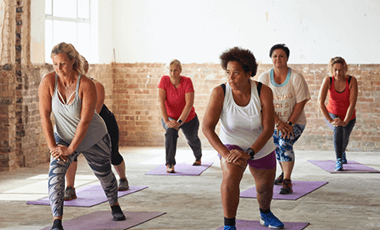
MOVING
Getting comfortable with being active

Regular exercise can be a fun way to do something good for you and your diabetes.
We know that staying active can help keep blood glucoseBlood glucoseThe main sugar found in the blood, and the body’s main source of energy. levels as close to normal as possible. That’s important for people of all ages with type 1 diabetes. But how do you get started if you haven’t been very active lately? These tips can help you start off right:
- Make physical activity part of your everyday life. You can add little things, like taking the stairs instead of the elevator. Or try walking the dog around the block a few extra times.
- Walk before you run. Walking more is a great start. Then, you may want to move from walking to running. How? Start walking normally, then try jogging for a few minutes. If you start to feel winded or out of breath, switch back to a brisk walk. Catch your breath and start again. Do what’s comfortable for you—but never stop challenging yourself!
- Keep a physical activity log. Before and after starting any physical activity, write down your latest blood glucose readings. This way you'll learn what works for you.
- Play it safe! Be sure to check with your diabetes care teamDiabetes care teamYour diabetes care team may include a primary care doctor, a diabetes and hormone doctor (endocrinologist), a registered nurse, a diabetes educator, a dietitian, a heart doctor (cardiologist), a foot doctor (podiatrist), an eye doctor (ophthalmologist/optometrist), a kidney doctor (nephrologist), a dentist, a pharmacist, and a mental health professional. before starting or changing a physical activity plan.
Don’t forget to check your blood glucose

Before starting physical activity, it's a good idea to check your blood glucose. Avoid physical activity if it’s too low or too high:
- If your blood glucose is less than 100 mg/dL, you may need an extra carbohydrate snack such as a piece of fruit or a few crackers. Then test 15 to 30 minutes later. Don’t start exercising until your blood glucose is above 100 mg/dL
- Do NOT exercise when your urine tests show ketonesKetonesOrganic compounds produced when the body breaks down fats and fatty acids to use as fuel. This is most likely to occur when the body does not have enough glucose or carbohydrates or the body cannot use glucose effectively. Because high levels of ketones are dangerous, a urine test is one way to check the level of ketones in your body. and your blood glucose is high. High levels of ketones and high blood glucose levels can mean your diabetes is out of control. Check with your doctor about how to handle this situation
Prepare for low blood glucose
Low blood glucose (hypoglycemia) following heavy activity is always a possibility, so:
- Be on the watch for symptoms of low blood glucose and respond quickly
- Keep a sugary snack or glucose tablets nearby when you are physically active in case blood glucose levels drop quickly
And make sure to celebrate success. Every step matters! Just start small and remember: Any move made toward being more physically active is a good one. Making lifestyle changes is not always easy, but you can do it!


